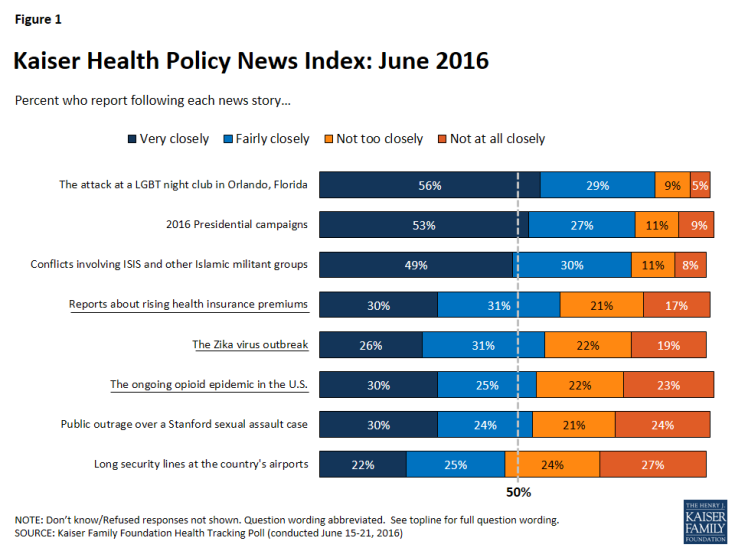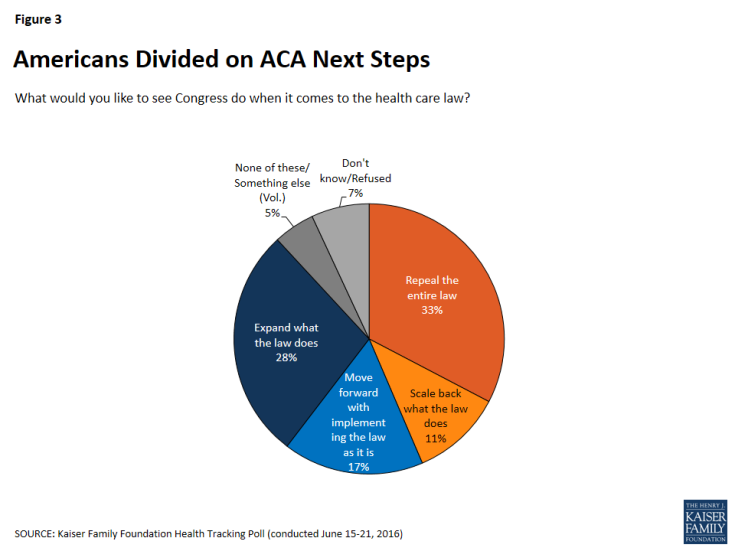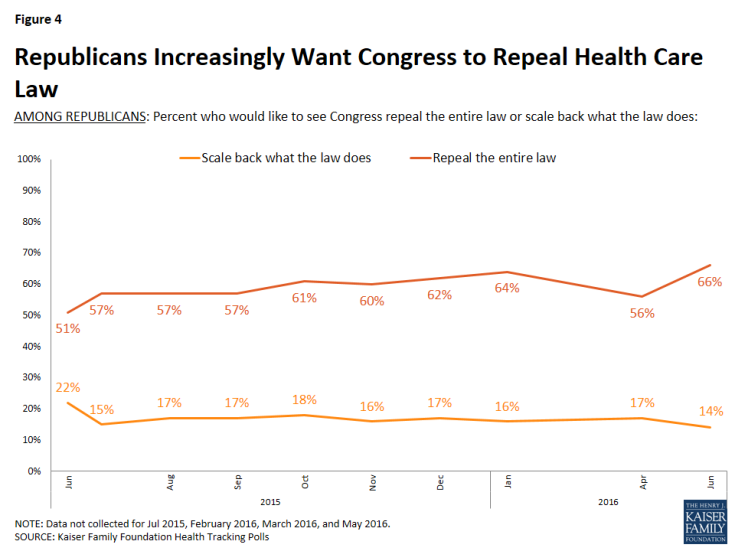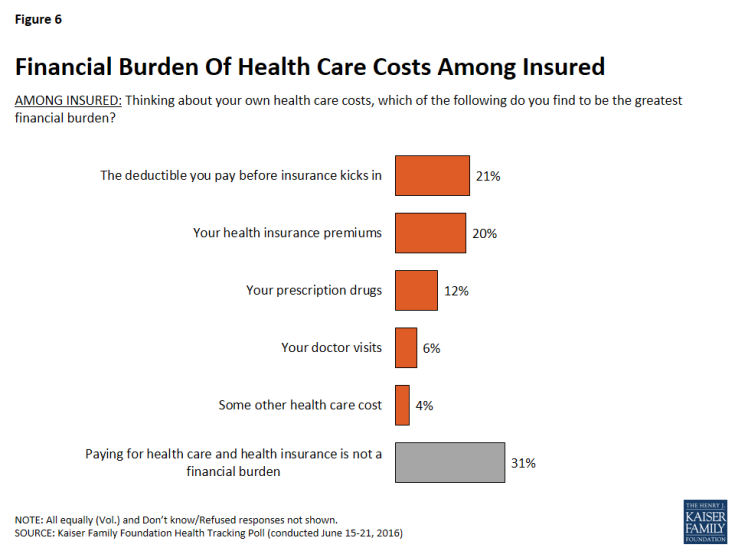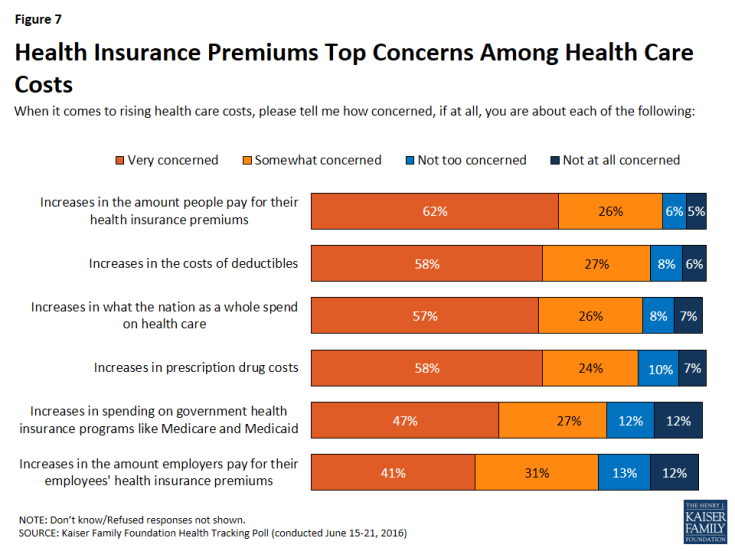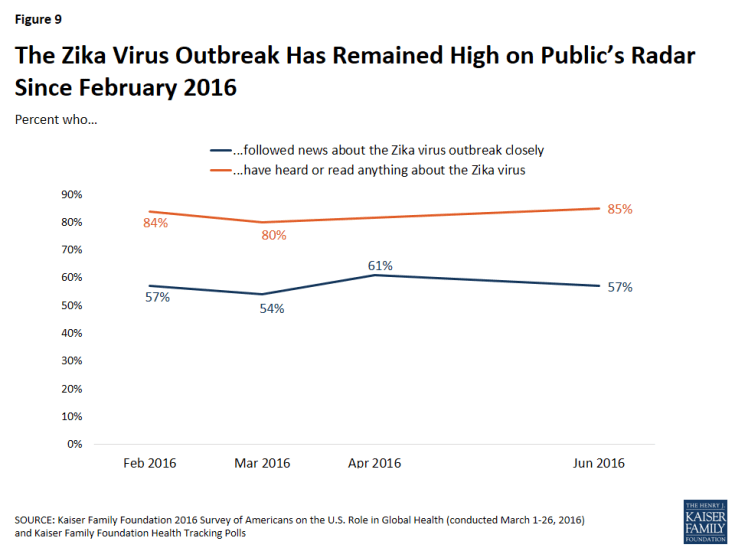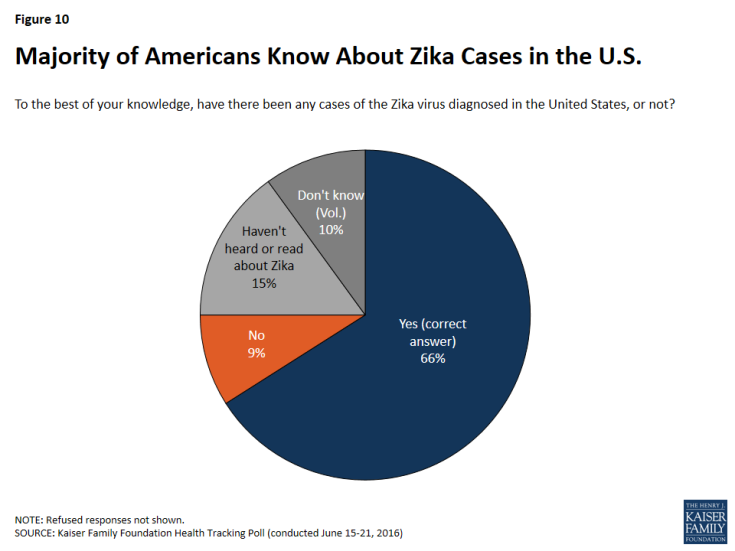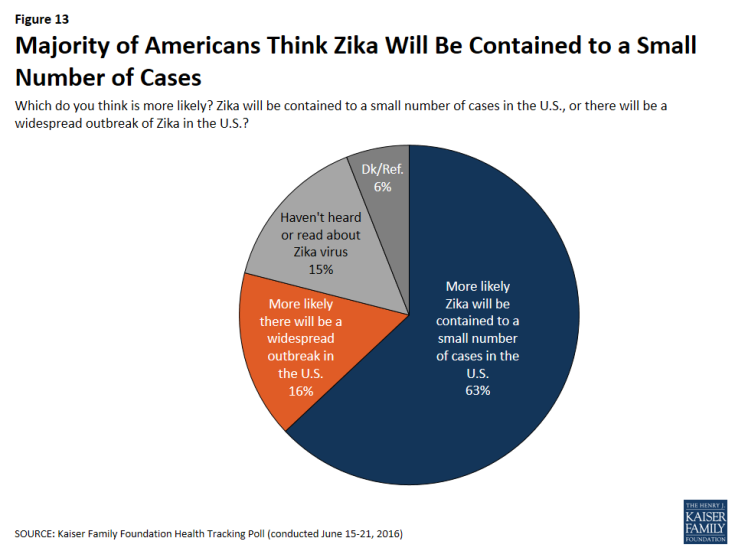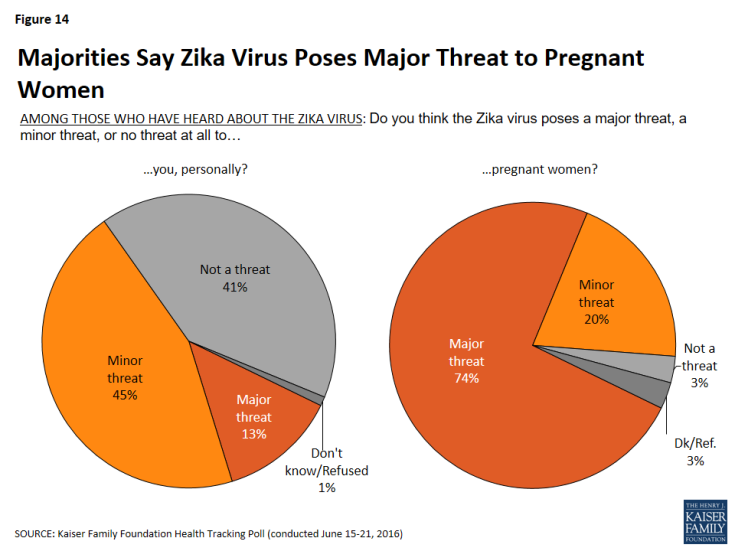Kaiser Health Tracking Poll: June 2016
KEY FINDINGS:
- Current attitudes about the ACA are divided, with 44 percent expressing an unfavorable opinion and 42 percent reporting a favorable opinion; 16 percent of Democrats report an unfavorable opinion, down from 25 percent in April.
- Increases in the amount people pay for their health insurance premiums tops health care costs concerns; premiums and deductibles are the biggest financial burdens.
- A majority of Americans are following the news about rising health insurance premiums, but the public doesn’t differentiate reports about ACA marketplace premiums from private insurance premiums overall.
- While the majority of Americans have heard about the Zika virus, only about one in ten (13 percent) know about the impact the virus can have on adults and only half are aware the virus can be sexually transmitted.
- There is widespread support for Zika-related assistance including funding for research, funding for preventing the spread of Zika, and helping women in areas in the U.S. with Zika virus outbreaks access reproductive health choices and services, including abortion, family planning, and contraception.
The Current News and Political Environment
The June Kaiser Health Tracking Poll examines the role of the major health policy news stories in the current news and political environment. In addition, it provides an in-depth analysis of two of the biggest health policy stories: the Zika virus outbreak and the rising costs of ACA health insurance premiums.
Kaiser Health Policy News Index: June 2016
This month’s tracking poll finds a large majority of Americans closely following news stories about the attack at a LGBT night club in Orlando, Florida (85 percent), the 2016 presidential campaigns (80 percent), and conflicts involving ISIS and other Islamic militant groups (79 percent). The top health stories during the month of June, both closely followed by about six in ten Americans, are the rising costs of health insurance premiums (61 percent) and the Zika virus outbreak (57 percent). In addition, 55 percent of Americans report following news about the ongoing opioid epidemic closely, similar to the share who report closely following outrage over the sentencing in a Stanford sexual assault case (54 percent). Finally, during the summer travel season, nearly half of Americans report closely following news about the long security lines at the country’s airports (47 percent).
Rising Health Insurance Premiums and the Impact of Health Care Costs on Families
Over the past month, one of the major health policy stories involves reports that health insurance premiums under the Affordable Care Act (ACA) may be increasing in 2017. This month’s tracking survey examines overall perceptions of the 2010 health care law and the impact that the rising costs may have on health care consumers.
The ACA and Health Care Costs
With rising health care costs on the minds of Americans, this month’s poll finds divided public opinion of the Affordable Care Act. The gap between favorable and unfavorable opinions narrowed nine percentage points between April and June, with the share of the public with an unfavorable opinion decreasing slightly from 49 to 44 percent and the share with a favorable opinion increasing slightly from 38 to 42 percent.
Since April, there has been a slight shift in favorability among Democrats, while attitudes among Republicans and independents have remained largely stable. Seven in ten Democrats (71 percent) now report a favorable opinion of the law, up from 63 percent in April. In addition, the most recent survey finds that 16 percent of Democrats report an unfavorable opinion, down from 25 percent in April.
Next Steps for the ACA
On June 22nd, House Republicans unveiled a conservative alternative to the Affordable Care Act.1 Overall, 33 percent of Americans want the law repealed, three in ten (28 percent) want to expand what the law does, one in five (17 percent) want to move forward with implementing the law as is, and about one in ten (11 percent) want to scale back what the law does.
Two-thirds of Republicans would like to see Congress repeal the entire 2010 health care law, up from 51 percent, 12 months ago. In contrast, this month’s poll finds that half of Democrats (48 percent) say they’d like to see Congress expand what the law does.
However, Republicans who want to see the law repealed are split on whether there should be a Republican-sponsored replacement for the law or not, with about three in ten Republicans reporting that they would like to see the law repealed and then replaced with a Republican alternative (29 percent) and one-quarter saying they would like to see it repealed and not replaced (25 percent).
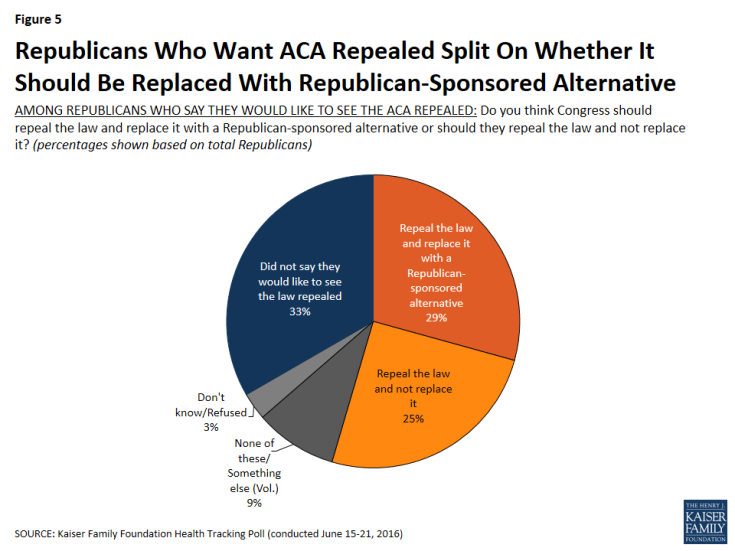
Figure 5: Republicans Who Want ACA Repealed Split On Whether It Should Be Replaced With Republican-Sponsored Alternative
Health Insurance Premiums
Among the insured, similar shares — about one in five — say the greatest financial burden of their own health care costs are the deductibles they pay before their insurance kicks in (21 percent) and their health insurance premiums (20 percent). One in ten say the cost of prescription drugs is the greatest financial burden (12 percent), 6 percent say it is doctor visits, and 31 percent say that paying for health care and health insurance is not a financial burden.
Overall, nearly nine in ten (88 percent) Americans say they are concerned about increases in the amount people pay for their health insurance premiums. This is followed closely by the percent who are concerned about increases in the costs of deductibles (85 percent), increases in what the nation as whole spends on health care (83 percent), and increases in prescription drug costs (82 percent). Fewer but still large majorities of insured Americans are concerned about increases in spending on government health insurance programs (74 percent) and increases in the amount employers pay for their employees’ premiums (71 percent).
Recent News About Rising Costs of ACA Marketplace Premiums
Despite the fact that 83 percent of the public say they have heard or read recent news about rising costs of health insurance premiums, individuals are uncertain about who and which plans are affected. Half of individuals (52 percent) say the reports have been about all insurance plans, 16 percent say the reports have been about just employer-sponsored plans, and one in ten say the news has only been about ACA Marketplace plans.
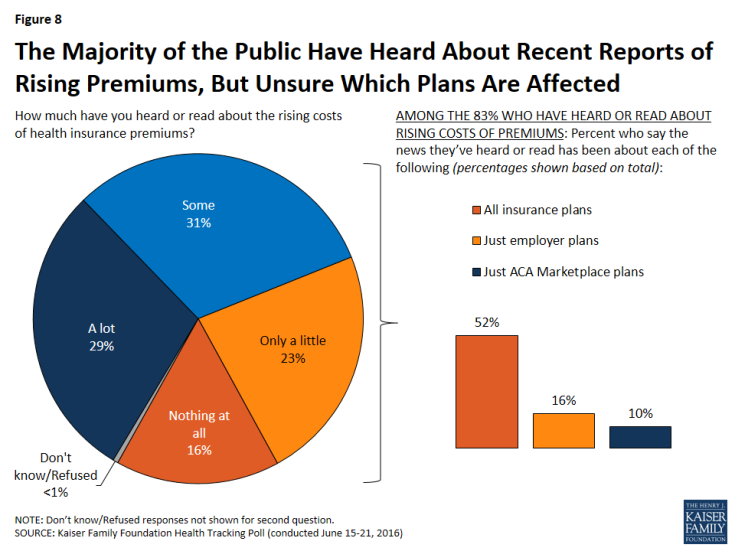
Figure 8: The Majority of the Public Have Heard About Recent Reports of Rising Premiums, But Unsure Which Plans Are Affected
The Zika Virus Outbreak
Due to ongoing developments about the potential threats of the Zika virus, concerns over the 2016 Summer Olympics, and congressional debate over funding allocation to limit the effects of the virus in the United States, the Zika virus outbreak was one of the most reported health policy stories during the month of June. The Zika virus outbreak has remained on the public’s radar since earlier this year,2 with more than half of Americans consistently reporting that they are closely following news about Zika and a large majority regularly saying they have heard or read about it.
According to the Centers for Disease Control and Prevention (CDC),3 there have been over 750 confirmed cases of the Zika virus across 45 states and Puerto Rico since January 2015. The June tracking survey finds that two-thirds of Americans are aware there have been cases of the Zika virus diagnosed in the U.S.
Overall Knowledge on Transmission of the Virus and Potential Impacts
There are mixed results when examining the public’s awareness of the ways the virus spreads and its potential effects. Eight in ten Americans are aware that the Zika virus can be spread through a bite of an infected mosquito (79 percent) and are aware that it does not appear to be spread through shaking hands with an infected person (79 percent). However, fewer – half (49 percent) – are aware that a person can become infected by having sex with someone who is infected.
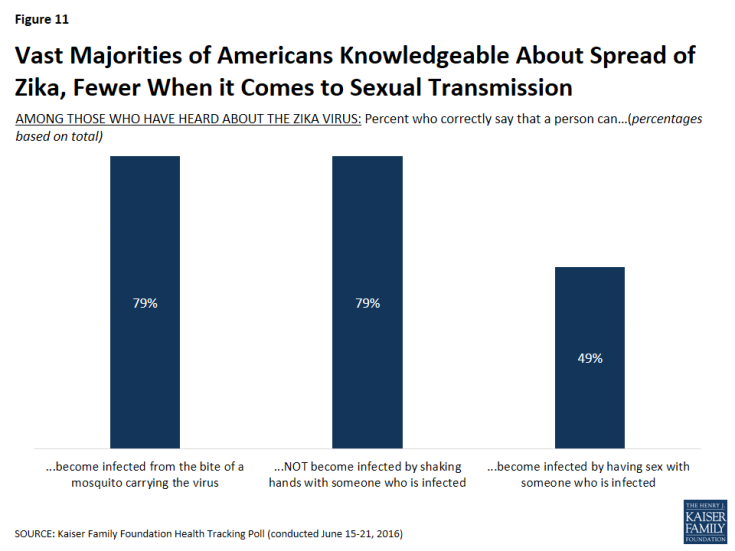
Figure 11: Vast Majorities of Americans Knowledgeable About Spread of Zika, Fewer When it Comes to Sexual Transmission
Americans are more likely to be aware of the connection between the Zika virus and birth defects than the potential impacts of the virus on adults. Six in ten Americans are aware that the Zika virus is associated with birth defects in babies born to infected mothers (59 percent), with one-fourth reporting that they haven’t heard enough to say, 15 percent reporting they haven’t heard or read about the virus, and one percent saying the virus is not associated with birth defects. Only one in ten Americans are aware that the Zika virus is associated with muscle weakening and paralysis in adults (13 percent), while two-thirds haven’t heard enough to say (67 percent), 15 percent haven’t heard or read about the virus, and 5 percent say the virus is not associated with muscle weakening and paralysis in adults.
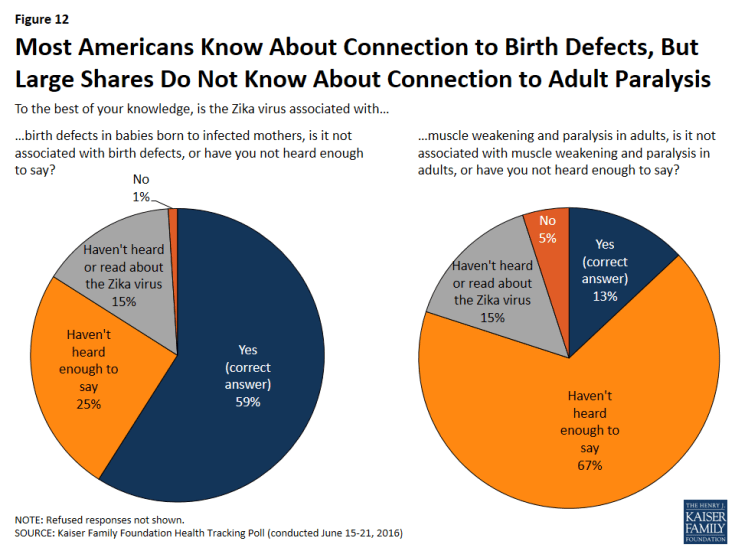
Figure 12: Most Americans Know About Connection to Birth Defects, But Large Shares Do Not Know About Connection to Adult Paralysis
Most Americans Do Not See The Zika Virus as a Personal Health Threat
Most Americans aren’t too concerned in general about Zika in the U.S., although there are some concerns about the threat the virus poses to pregnant women. Overall, the majority of Americans (63 percent) think Zika will be contained to a small number of cases in the U.S. rather than a widespread outbreak (16 percent), and of those who have heard or read anything about the virus, only 13 percent say they think the Zika virus poses a major threat to them personally, while almost equal shares say it poses a minor threat (45 percent) or not a threat at all (41 percent).
Despite this, three-fourths of Americans who have heard or read anything about the virus say the Zika virus poses a major threat to pregnant women (74 percent), with an additional 20 percent who say it poses a minor threat and only 3 percent who believe it does not pose a threat.
Hispanics More Likely to Perceive the Zika Virus as a Threat
The perceived personal threat posed by the virus differs dramatically by ethnicity, with almost one-third of Hispanic individuals who have heard or read anything about the virus saying the Zika virus poses a major threat to them personally, compared to about one in five Blacks (21 percent) and only 7 percent of whites. Hispanics are also more likely to report being worried about the potential effects of the Zika virus. More than half of Hispanics who have heard or read anything about the virus say they are worried that they or someone in their family will be affected by the virus, 43 percent are worried the U.S. will see a large number of Zika-related cases, and one-third are worried that the upcoming Summer Olympics will lead to an increase in Zika-related cases. Across all of these measures, a larger share of Hispanics report being “very worried” than Blacks (36 percent, 27 percent, and 24 percent, respectively) and whites (10 percent, 16 percent, and 19 percent, respectively).
| Table 1: Hispanics Are More Worried about the Zika Virus than Non-Hispanics | ||||
| Among those who have heard or read anything about the virus, the percent who say: | Total | Hispanic | Black/Non-Hispanic | White/Non-Hispanic |
| They are very worried that they or someone in their family will be affected by the Zika virus | 20% | 52% | 36% | 10% |
| They are very worried that the upcoming Summer Olympics will cause an increase in the number of cases of the Zika virus | 22 | 33 | 24 | 19 |
| They are very worried that the U.S. will see a large number of cases of the Zika virus | 21 | 43 | 27 | 16 |
| The Zika virus poses a major threat to them personally | 13 | 31 | 21 | 7 |
While Zika mainly threatens areas in the U.S. with warmer climates, there are only slight regional differences in overall concerns about the virus. However, there are differences based on whether an individual says there are a lot of mosquitos in their area during the summer. Slightly larger shares of individuals who say they live in areas with a lot of mosquitos report being worried about potential effects of the virus on themselves or their family members than individuals living in areas without a lot of mosquitos, 40 percent and 34 percent, respectively.
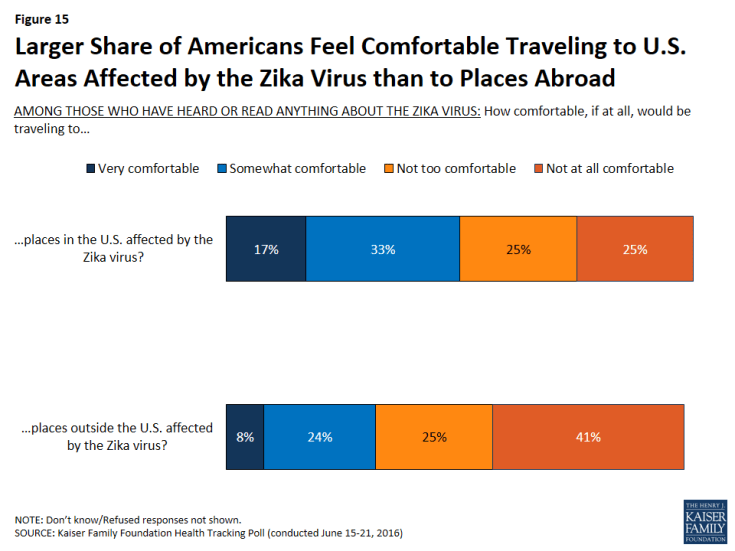
Figure 15: Larger Share of Americans Feel Comfortable Traveling to U.S. Areas Affected by the Zika Virus than to Places Abroad
The Impact of the Zika Virus on Travel Plans
Half of Americans who have heard or read anything about Zika say they would feel comfortable traveling to places in the U.S. affected by the Zika virus, with 17 percent saying they feel “very comfortable” and one-third saying they feel “somewhat comfortable.” This compares to one-third of Americans who would feel comfortable traveling to places outside the U.S. affected by the Zika virus – 8 percent say they are “very comfortable” and 24 percent say they are “somewhat comfortable.” In fact, four in ten Americans say they are “not at all comfortable” traveling to places outside the U.S. affected by the Zika virus (41 percent).
Widespread Support for Funding Aimed at Limiting the Effects of Zika
With legislation that would provide additional funding to combat the Zika virus stalled in Congress, the majority of Americans say it is important for government funding aimed at limiting the effects of Zika to include funding for both killing the mosquitos that spread the virus and access to reproductive health services for at-risk women. Nearly six in ten Americans it is “very important” to include funding for killing the mosquitos that spread Zika (57 percent), with an additional 22 percent saying it is “somewhat important.” Only 5 percent say it is “not very” or “not at all” important. In addition, a smaller share but still half of Americans say it is “very important” to include funding for access to reproductive services for at-risk women (49 percent), with an additional 20 percent saying it is “somewhat important.”
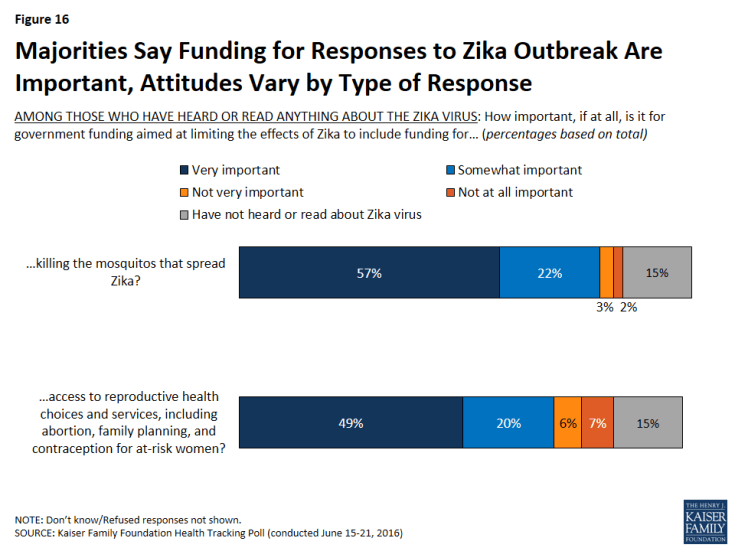
Figure 16: Majorities Say Funding for Responses to Zika Outbreak Are Important, Attitudes Vary by Type of Response
There are partisan differences in support for Zika-related funding, with Democrats and independents reporting higher levels of support than Republicans. Majorities of Democrats and independents say the U.S. should invest more money in research on the Zika virus, invest more money to prevent the spread of Zika, and help women in areas in the U.S. with Zika virus outbreaks access reproductive health services. It is worth noting that two-thirds of Republicans support investing more money in research on the virus and investing more money on preventing the spread of Zika in the U.S., but slightly less than half support helping women in areas in the U.S. with outbreaks of the virus access reproductive health services.
| Table 2: Majorities of Democrats, Independents, and Republicans Support Zika-Related Assistance | ||||
| Percent who say the U.S. should… | Total | Democrats | Independents | Republicans |
| Invest more money in research on the Zika virus | 73% | 81% | 73% | 68% |
| Invest more money to prevent the spread of Zika in the U.S. | 72 | 80 | 72 | 66 |
| Help women in areas in the U.S. with Zika virus outbreaks access reproductive health choices and services, including abortion, family planning, and contraception | 65 | 81 | 65 | 46 |

